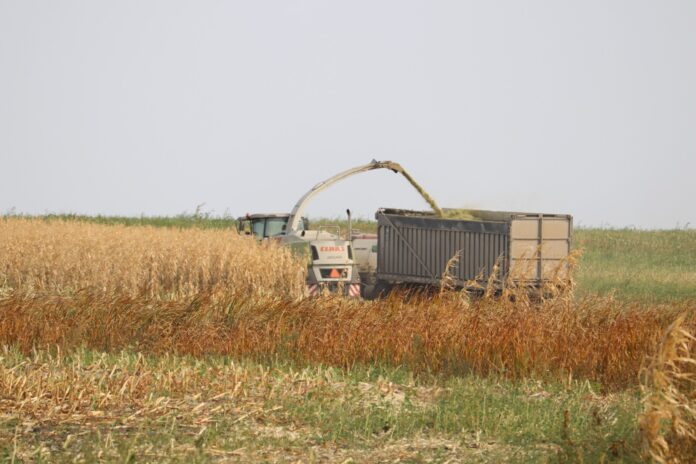A theme of discussions around the next farm bills is “protect
crop insurance.
” But that often is followed up with something like, but “there are things we can do to
tweak it
.”
So what are some of those things? An Aug. 8 roundtable discussion in Fargo led by Sen. John Hoeven, R-N.D., brought forth several ideas from leaders of commodity groups and the crop insurance industry.
“North Dakota farmers use it at a higher percentage per capita than any state in the nation. So when it comes to the farm bill, really, crop insurance is No. 1,” Hoeven said.

Jeff Beach / Agweek
Without getting too deep into the weeds of some complex issues, here are some of those ideas:
Make higher coverage more affordable
Farmers would like to see more premium support for 80% and 85% coverage levels. In North Dakota, northern Minnesota and many other states, most crops are insured at the 70% and 75% levels. In states like Iowa and Illinois, they’re insured at 85% level because the cost is much less. Increasing the premium support will encourage farmers to insure at the higher levels and reduce the need for ad hoc disaster programs.
“That’s something I am going to push for very hard right off the bat,” Hoeven said, after Howard Olson of AgCountry Farm Credit Services brought up the idea. Farm bill negotiations will resume after Labor Day.
While some crop insurance tweaks can be made outside of farm bill discussions, this is not one of them.
“Unless it’s changed by Congress that we change the premium subsidy, it’s going to cost more,” said Marcia Bunger, administrator for the Risk Management Agency that was there to gather input.
Bunger, who ranches with her husband in southeast South Dakota, explained that coverage is cheaper in Iowa and Illinois and North Dakota and South Dakota because “we have more train wrecks than our neighbors,” she said, referring to crop disasters.
But Hoeven said that, along with the diversity of North Dakota, being less corn and soy focused, puts North Dakota at a disadvantage.
“But the product is still basically the same product so the farmer in Iowa can buy up to a higher percentage coverage than we can because of those differences and that’s not fair,” Hoeven said. “And so it needs to work better where you have large counties and diverse agriculture like we do in North Dakota.”
Find a way to subdivide counties
Speaking of large counties, area yield programs like the Enhanced Coverage Option and Secondary Coverage Option are calculated on average yield in a county. If there was a way to subdivide large counties with diverse growing conditions, farmers with losses would be less likely to be penalized by a great crop 50 miles away but in the same county.

Iowa has more counties (99) in just 56,273 square miles than North Dakota has (53) in 70,705 square miles.
And Iowa counties are relatively uniform in size in comparison to the Dakotas and Minnesota, especially northern Minnesota.
“A lot can happen in 10 miles, let alone 90 miles in distance inside a county,” said Jared Billadeau of the North Dakota Grain Growers Association.

Jeff Beach / Agweek
Matt Perdue of North Dakota Farmers Union, North Dakota’s large farm organization, said the geography issue keeps popping up with members.
“You go to Iowa, they don’t have as variable of weather, they don’t have as variable of growing conditions, and every county is 16 townships, it’s a perfect square. And so ECO is a great policy there, it works pretty consistently across the state. And in North Dakota, it’s winners or losers on any given year,” Perdue said.
While conceding there will never be a perfect system, Hoeven said it needs to be better.
Split corn for grain from silage

Mikkel Pates / Agweek file photo
Producers currently have to insure all their corn even though livestock producers may chop some of it for silage — a lower value crop than corn for grain. And that Sept. 30 cut off date for harvesting silage is waaaaay too early.
Tim Erbele of the North Dakota Stockmen’s Association said growing corn for silage has changed. There are now corn varieties bred to be chopped for livestock feed that mature later than in decades past. But those operations are also growing corn for grain.
Katie Vculek of the North Dakota Corn Growers Association said her group has compiled data to support this change.
A premium product for food-grade soybeans and soybeans for seed

Eric Hylden / Grand Forks Herald file photo
Like a different insurance product for corn silage, how about letting soybean growers pay a higher premium to insure at a higher rate for those crops that should get a premium price, but also carry more risk?
“If you’re growing seed production, you typically would have higher costs associated with growing, higher potential revenue opportunity, but you’re insuring it with the rest of your soybeans,” Justin Sherlock of the North Dakota Soybean Growers Association said.
He said he gets a premium of 60 cents to $1.20 for soybean seed.
“I’m sure there’s a way to put a price on what it would cost to insure seed production soybeans over commodity soybeans,” he said.
He said ECO and SCO programs can help, but their complexity turns many farmers off.
“The complexity of some of this stuff is a concern,” Hoeven said.
Revenue protection on sugarbeets

Jeff Beach / Agweek file photo
A revenue protection model of insurance could take into account factors other than tons of beets harvested for Actual Production History.
“We’re working to submit a proposal to implement a revenue based type crop insurance program for sugarbeets,” said Darren Hoyme of the Red River Valley Sugarbeet Growers
“The current APH program does meet our growers’ needs with respect to yields, but sometimes there’s gaps when it comes to sugar content and differences between co-ops within the country.”
Simplify and push back canola planting dates

Mikkel Pates / Agweek file photo
There are four different cut off dates for canola planting in North Dakota based on location. Cutting that to two would be simpler and they should be pushed later.
Barry Coleman of the Northern Canola Growers said in southwest North Dakota this year, one grower’s best looking canola was planted eight days after the final crop insurance date.
“Last year, a lot of the canola got in late and we had terrific yields,” he said. “Planting later is not an issue”
Get rid of outdated production history

Mikkel Pates / Agweek file photo
Farmers may have dropped small grains or sunflowers or another crop from their rotation years ago but that crop might still be on their insurance policy. But because they have not been planting the crop and creating an Actual Production History, insurance may not be available.
One suggestion from Doug Johnson, of Tri-County Insurance, Fargo, was to use the Determined Yield request process if the farmer has not raised that crop twice in the last 10 years in the county. A Determined Yield request is a tool that is available, but it is usually used for farmers who have dropped coverage. By using that tool for farmers with continuous coverage, they could request using the transition yield — referred to as the T yield — in the county to substitute for the APH.
“We’ll put in a Determined Yield Request and because we kept sunflowers on the policy continually for the last 20 years, even though they haven’t been grown, there’s no break in continuity, so yield determination gets kicked out,” Johnson said.

Jeff Beach / Agweek
But Johnson said no one can point to a written policy to back up denying the request. “They just say it’s standard APH procedure,” Johnson said.
While Hoeven and other members of Congress will be working on the farm bill, which expires Sept. 30, he said crop insurance is always being assessed for possible changes or new products.
“We work with all of the administrators to always do what we can to strengthen crop insurance because it is so important to our farmers and we want to do more for ranchers with crop insurance, too,” Hoeven said.





![[Toyota Times] From Strengthening Foundations to Boosting Productivity – Toyota Focuses on Break-Even Volume [Toyota Times] From Strengthening Foundations to Boosting Productivity - Toyota Focuses on Break-Even Volume](https://businessfortnight.com/wp-content/uploads/2025/11/Toyota-Times-From-Strengthening-Foundations-to-Boosting-Productivity-Toyota-218x150.jpg)





























